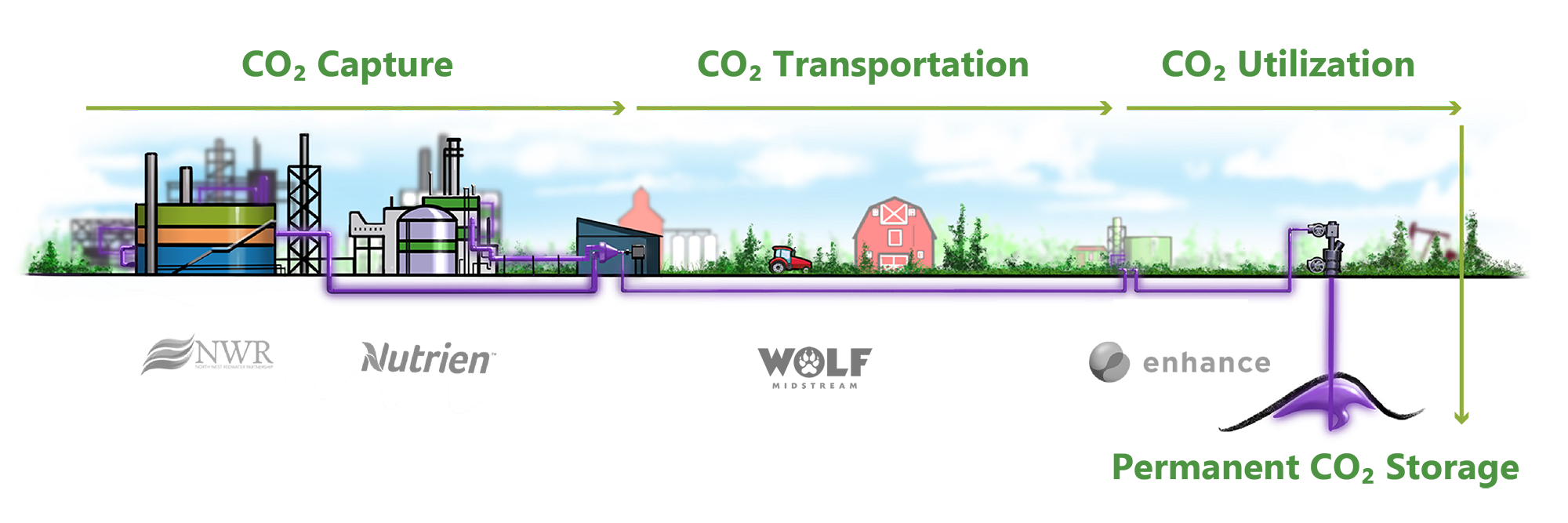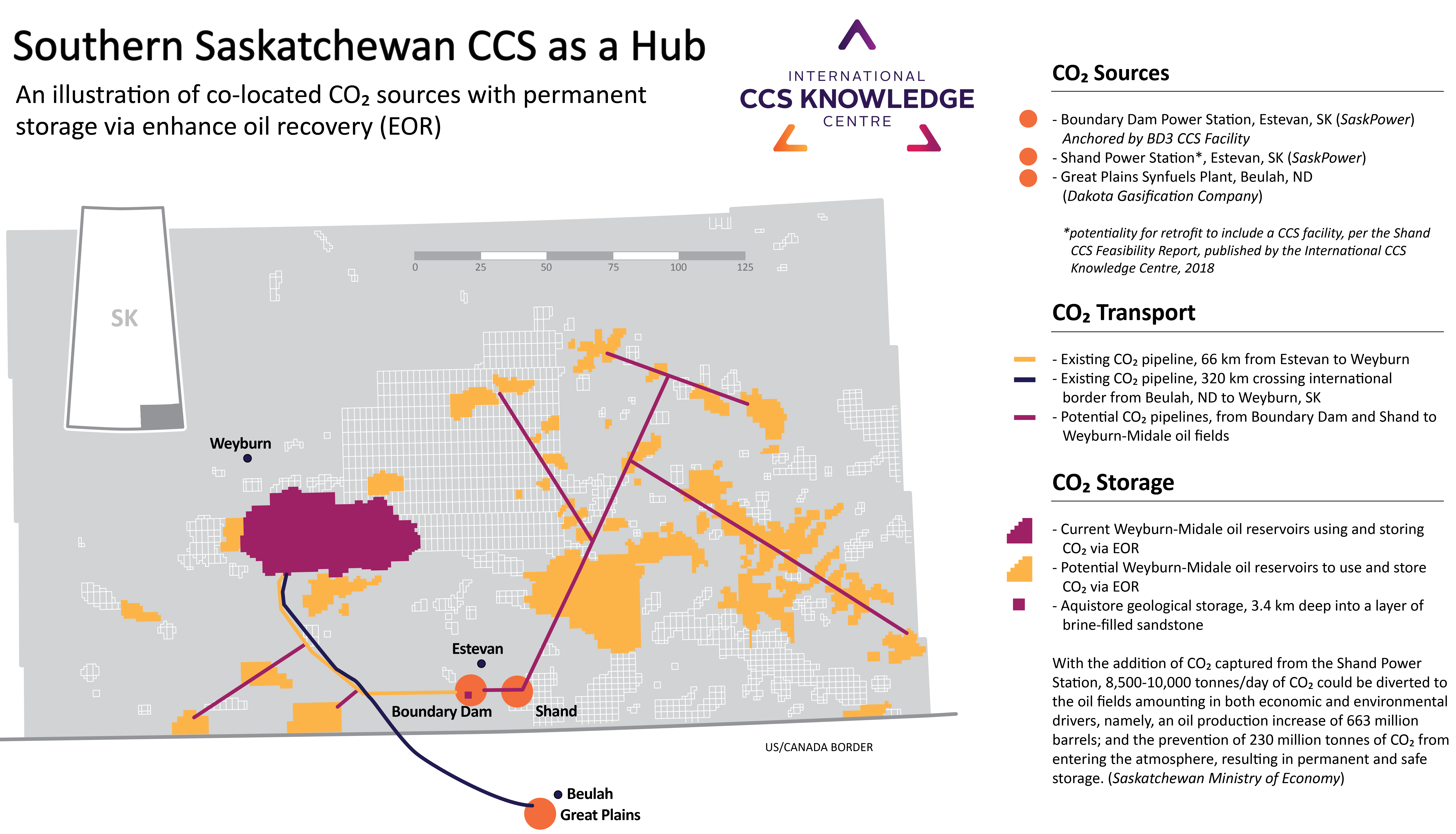I come from the eastern reaches of Canada where the province of Newfoundland & Labrador is surrounded by the Atlantic Ocean – where fishing used to be the foundation on which the economy was built. The fish merchants had big houses in the capital city of St. John’s, and the people who caught the fish were spread all over the bays along the coast. The city with its busy port was a hub of activity. Like the small city of St. John’s, many of our largest global cities are founded because of the ports they house – like Shanghai, London, New York. Such hubs receive the benefit of shared infrastructure, an economic marketplace, and, in general, a cluster of activity happening around it. Not all hubs are at ports of course. In the carbon capture and storage (CCS) space, we look at a cluster of industry as a target for many emissions reductions at a potential lower cost because of their “hub” nature.
ALBERT CARBON TRUNK LINE
The Alberta Carbon Trunk Line (ACTL) system launched in Alberta, Canada in June 2020. It is a perfect example of a hub with the commendable addition of a “build it and they will come” approach to their 14.6Mt capacity pipeline. Self-defined, the ACTL is “designed as the backbone infrastructure needed to support a lower carbon economy.” (Watch a great video about ACTL).
The ACTL system currently captures CO2 from two anchor projects – a refinery and a fertilizer facility (Sturgeon Refinery owned by North West Redwater Partnership (NWR) and Nutrien’s Redwater Fertilizer Facility). In the world of CCS, refineries and fertilizer facilities, depending on their operations, can be a low-hanging fruit option for capture thanks to the relatively easy access to CO2 – i.e. there are less particulates in the flue gas than in, say, a coal plant. These two large-emitting facilities have the capacity to capture about 1.6Mt/yr, but the pipeline itself, owned by transporter Wolf Midstream, has the capacity to see many more projects use this shared infrastructure.

The win-win situation of environmental benefits with lower greenhouse gas emissions (GHGs) coming from enhanced oil recovery (EOR) in Alberta’s oil sands have made this project gain momentum – especially with the price on carbon and EOR offset protocol (stay tuned for more on that in an upcoming Blog). When there are several emission sources situated around storage options, creating a CCS hub can be an economical solution for large emission reductions in the near term. I don’t think we have seen the last from viable CCS hubs and networks in Alberta.
SOUTHERN SASKATCHEWAN AS A CCS HUB
In its Shand CCS Feasibility Study, the Knowledge Centre worked with the Government of Saskatchewan and identified a potential hub for southern Saskatchewan. Currently there are two pre-existing anchor projects in the area – the first of which was established two decades ago – with an international agreement between the US and Canada for a border crossing from the Dakota Gasification Company’s (DGC) Great Plains Synfuels Plant outside Beulah North Dakota to Whitecap’s Weyburn Oil Unit. The second network includes CO2 captured from Boundary Dam 3 CCS Facility (BD3) in Estevan that is transported 66km to Weyburn by pipeline. This hub includes permanent storage utilizing EOR into the Williston basin, and also sees a portion of the CO2 captured from BD3 being stored 2km away at the Aquistore Storage Project.

FINANCING AND INVESTING
CO2 hubs – call it a backbone, a trunk line, or a gathering route – are perfect low carbon economy investments. Leveraging multiple players including government, industry, and the finance community. Shared infrastructure with access to available storage capacity (be it in a reservoir or with EOR) allows emitters to separate investment decisions to focus on their own footprint versus the entire full chain development. It is the hope of many that such hubs will rapidly increase CCS deployment and minimize investment risk.
Government contributions still remain crucial for CCS
Government support is crucial for CCS to really reach a larger scale globally, but in some countries like Canada, those dollars are no longer as readily available due to CCS being looked at as “no longer first of a kind”, thus making grant receipt difficult. Therefore, examining other mechanisms to leverage government support is necessary.
A pipeline like the ACTL is a good way to stimulate infrastructure dollars that can be actively utilized by several industries and may entice others who now have a nearby route to the “S” part of CCS to consider implementing carbon capture at their facilities. In the same way that governments function to provide infrastructure dollars for shared road usage, a CO2 highway with on and off ramps is a great example of where government dollars could have an exponential impact. This applies to land-based hubs with pipelines as much as it does to ports with trucked or shipped CO2.
The ACTL CAD$1.2B system received government support for the network: the Canadian government contributed CAD$63.2M in funding under its ecoEnergy Technology Initiative and Clean Energy Fund, and the province of Alberta provided CAD$459M through its dedicated Carbon Capture and Storage Fund.
There is value for investors too
Financiers and the investment community are also taking note of the advantages to hubs and the value to reducing costs via shared CO2 infrastructure. Wolf Midstream’s ACTL pipeline is backed by the Canadian Pension Plan Investment Board (CPPIB) committing up to CAD$305M to Wolf to fund the project.
It is not just hundred-billion-dollar pension funds interested in CCS hubs. So are the giant oil and gas companies involved in the Oil and Gas Climate Initiative (OGCI). In 2019, as a part of the OGCI Climate Investment’s USD$1B+ fund, the initiative launched five “kick-starter” CCUS global hubs with prospects for up to 25 additional ones around the world. Their aim is to facilitate large-scale commercial investment and create market conditions for CCUS to play a significant role in decarbonization – specifically by pursuing CO2 capture at several industrial sources within one region, using economies of scale, and sharing transport and storage infrastructure.
With the aptly named “kick-starter”, the five hubs total a potential of 230Mt CO2 capture per year:
|
OGCI CLIMATE INVESTIMENT KICKSTARTER HUBS |
POTENTIAL IMPACT BY 2030 |
|
Hub 1: Net Zero Teesside, UK |
Over 6 mtCO2 per year |
|
Hub 2: Northern Lights, Norway |
5 mtCO2 per year |
|
Hub 3: Rotterdam, Netherlands |
10 mtCO2 per year |
|
Hub 4: Xinjiang, China |
Over 3 mtCO2 per year |
|
Hub 5: Gulf of Mexico, USA |
Over 200 mtCO2 per year across 2-3 defined hubs in Texas and Louisiana |
For details of each of these hubs, I encourage you to visit OGCI Climate Investments CCUS kick-starter.
Probably the most impactful OGCI Climate Investments’ kick starter hubs are in the Gulf of Mexico with total CO2 emissions targeted at over 200Mt/yr in Texas and Louisiana spanning various industries : power plants, refineries, chemical plants, fertilizers, and hydrogen; and leveraging involvement from companies like Occidental, Shell, ExxonMobil, BP, Chevron, Repsol, and Total.
The clusters of industry coupled with the 45Q tax credit in the US and the nature of the Gulf Coast and large oil company action in the area make this an optimal hub for CCS. The 45Q tax credit creates a government grant-like incentive for innovation in CCS as an emission reduction technology, providing USD$50 per tonne of CO2 geologically stored, and USD$35 per tonne for CO2 utilization – including EOR, with no cap on the amount possible to be received. This provides certainty for developers and creates fast moving action because to qualify, projects have to start construction before the end of 2023. It is interesting to note that OGCI member companies and Climate Investments are active in eight of the CCUS projects announced that plan to use 45Q tax credits.
WISDOM OF PORTS
As I reflect back on the founding strengths of the fishing ports of my home province, I cast my mind forward to the nature of a CCS hub, and its wide potential of clustering activity to happen around it and as a result of it. The world can collectively work to meaningfully reduce emissions across sectors as it moves from the parable of “providing one fish” to the community , to a place where through sharing infrastructure within an economic marketplace, and working together to understand the regional and local nuances of development, it can “teach a man to fish,” fostering a CCS network for years to come.
A variation of this article was also featured in the Sep/Oct 2020 issue of Carbon Capture Journal